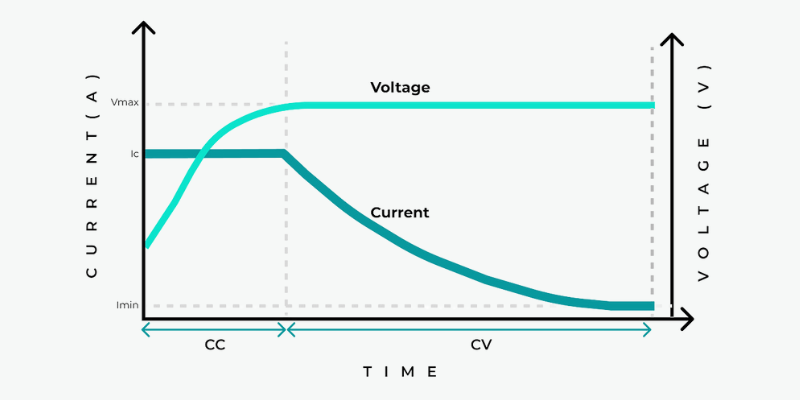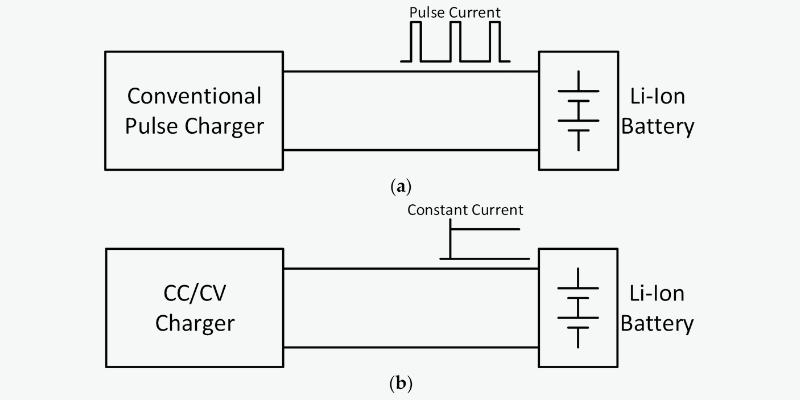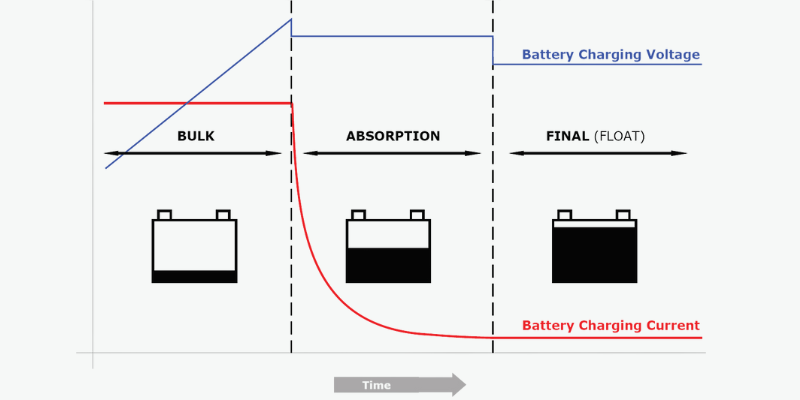Key Takeaway:
- Select the right charging technique for your battery to maximize efficiency, minimize damage, and extend its life. From constant voltage to random charging, each method impacts battery health differently.
Battery charging methods affect performance and lifespan. Excessive current prevents full reactions, increasing resistance and temperature, damaging materials. Low current extends charging time, inconveniencing users. Choosing the right charging method is crucial to maximize performance without lengthy charging.
In this guide, we’ll explore 9 common battery charging types – from constant voltage charging to the random charging.
Constant Voltage Charging
The constant voltage charging method uses a fixed voltage source to charge batteries. Its advantages include a simple circuit structure and easy control circuit design.
In this mode, the charging current decreases as the battery approaches full charge. Once fully charged, the charger automatically switches to float charging, maintaining the battery’s full charge.
However, this method has a drawback. In the early charging stages, the low battery terminal voltage results in an excessively high initial charging current. This can damage battery plates, increase battery temperature, and shorten battery life.
To address this issue, a multi-stage voltage charging method can be employed. This approach uses a lower charging voltage initially, then increases it as the battery terminal voltage rises.
Constant Current Charging
The constant current charging method charges the battery with a steady current.
Like the constant voltage method, when the battery is fully charged, the charger must switch to float charging mode to prevent damage from overcharging.
Compared to constant voltage charging, this method can fully charge the battery quickly.
However, it must monitor the battery’s charging level closely. Since the charger continuously provides a constant current, failure to stop charging or switch to trickle mode when the battery is full will result in overcharging. This can damage the battery plates and reduce the battery life.

Taper Current Charging
Taper Current Charging is a process where the charging current gradually decreases as the cell voltage, or back electromotive force (back emf), increases. This method uses an unregulated power source, where voltage and current are not finely controlled.
As the battery charges, its internal resistance decreases, allowing more current to flow until the battery reaches full charge.
However, unregulated charging poses risks, including overcharging. This can lead to excessive heat, gassing, and battery damage, reducing lifespan and creating safety hazards if not carefully managed.
Taper Current Charging is suitable for SLA batteries only.
Pulsed Charging
Pulse charging uses periodic pulse current to charge batteries. The pauses in charging allow the electrolyte to diffuse more evenly, improving efficiency. This enables the charging energy to be fully converted to electrical energy, resulting in higher charging efficiency.

Burp Charging
Reflex or negative pulse charging, also called ‘burp charging’, is a method that applies a very short discharge pulse during a charging rest period to depolarize the cell.
This pulse, typically 2–3 times the charging current for 5 ms, aims to dislodge gas bubbles built up on the electrodes during fast charging.
This process, known as ‘burping’, speeds up stabilization and the overall charging process. Proponents claim this technique improves charge rates, battery lifetime, and removes dendrites. However, these claims remain controversial.
IUI Charging
This is a fast charging profile for specific flooded lead-acid batteries, not suitable for all lead-acid batteries.
It has three phases:
1. Constant current (I) charge until the voltage reaches a preset level near the gassing point (bulk charge).
2. Constant voltage (U) charge with gradually decreasing current, completing the normal charge.
3. Constant current (I) charge up to a higher preset limit, equalizing the cell charges to maximize battery life.
Trickle Charging
Trickle charging maintains a fully charged battery by matching its self-discharge rate.
This occurs when the battery is not in use, as trickle charging cannot keep a battery charged if current is being drawn.
In lead-acid batteries under no-load float charging, trickle charging naturally happens at the end of charging, when the battery’s internal resistance increases and reduces the charging current to a trickle. This equals the energy lost from the battery splitting water in the electrolyte.
Other battery types, like lithium-ion, cannot be safely trickle charged.
Float Charging
Float charging keeps a battery’s charge by applying a continuous, minimal voltage and current to keep it fully or nearly fully charged.
It’s commonly used for backup and emergency power where the battery is discharged infrequently.
During float charging, the charger, battery, and load are connected in parallel. The charger powers the load during normal operation, with the battery providing backup power if the main power fails.

Random Charging
Many applications involve uncontrolled battery charging, such as automotive uses where energy depends on engine speed.
This is especially problematic for EVs and HEVs with regenerative braking, which generates power surges the battery must absorb.
Solar panel installations also only charge when the sun is shining. These applications require techniques to limit charging current or voltage to safe battery levels.
Conclusion
Selecting the appropriate battery charging method is essential for optimizing performance and extending battery life. Each charging technique offers unique advantages and challenges. By understanding these methods and their implications, we can ensure safe, efficient battery charging practices.
As a custom lithium battery supplier, Holo Battery offers in-house charging services. We have standard equipment and can create custom charging solutions to meet all requirements. This allows us to deliver rechargeable battery packs that are fully charged to customer specifications, ready for immediate use in end products.

